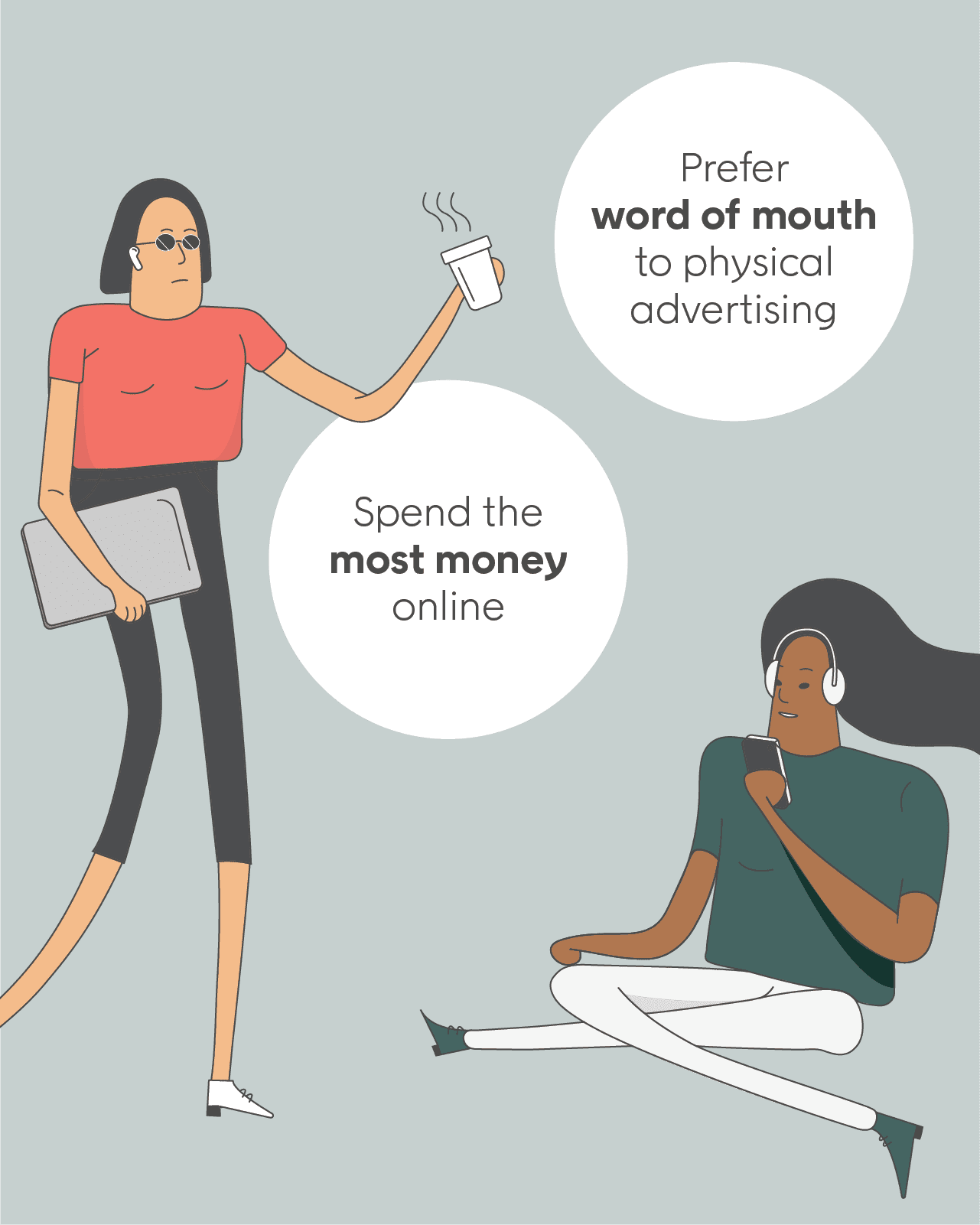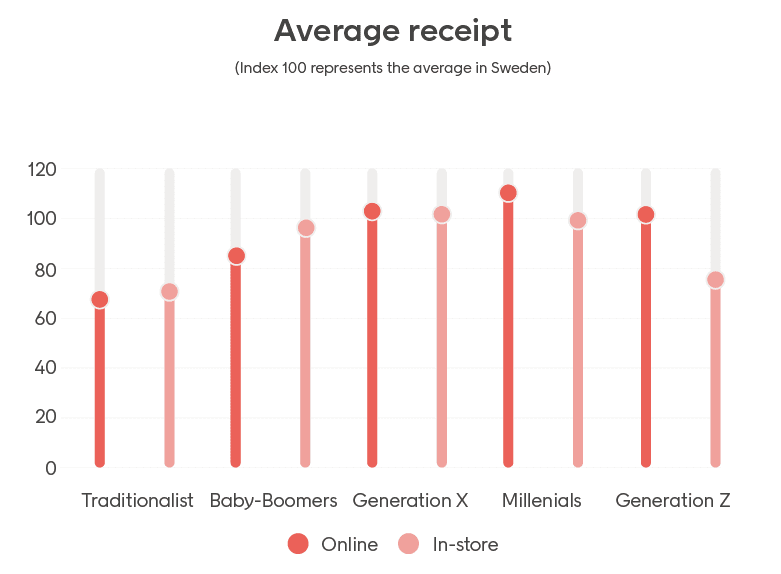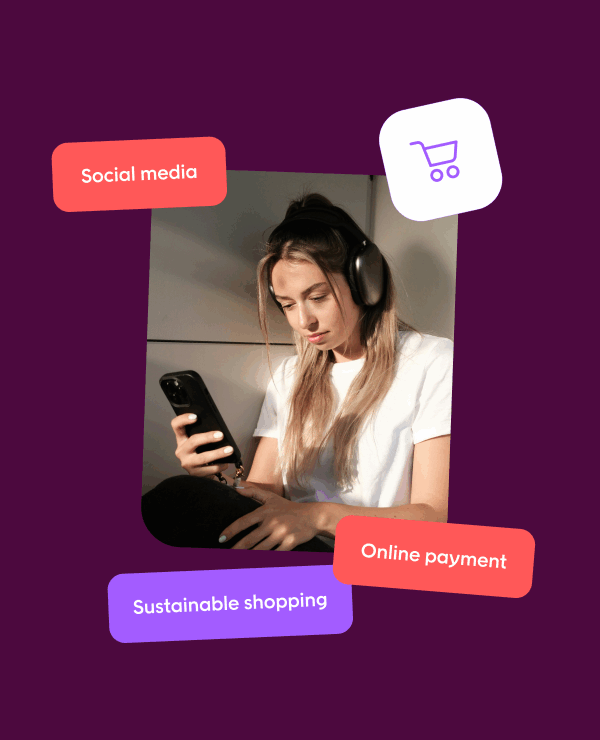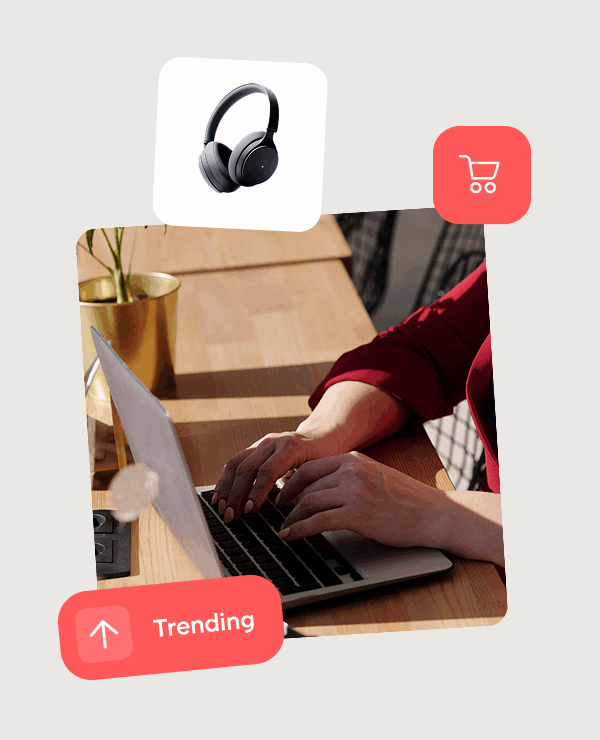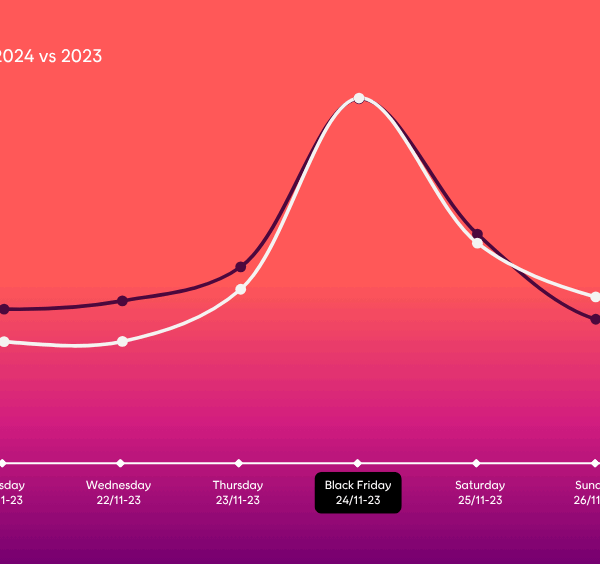Marketing to reach each generation
One of the most important things to consider when it comes to marketing to reach each generation is segmentation. You need to know how purchase behavior and preferences vary by generation. There are a lot of stereotypes out there; older people don’t shop online, young people return most of their purchases, etc. But what is actually true? It’s time to break down the generational trends and decipher once and for all how you should target each generation.
The generations we’ll discuss in this guide are:
- Generation Z: Born 1996 – 2010
- Millennials: Born 1977 – 1995
- Generation X: Born 1965 – 1976
- Baby Boomers: Born 1946 – 1964
- Traditionalists: Born 1945 and before

Get the guide: Optimize your marketing to reach each generation
The Voyado index looked at 3,6 million transactions to understand purchase behavior in loyalty programs. Things we looked at were how generations vary in where they prefer to shop (online or in-store), how much they spend, how differently they respond to your communication, and how to return behavior differs. Meaning, there’s a lot of great stuff to learn when you want to do marketing to reach each generation.
Millennials spend the most online
Younger people generally account for bigger purchases, especially online. Their average receipts are larger than the older generations. However, the research also showed that older people have more purchase occasions, both online and in-store, where 70-75 years account for the most purchase occasions overall. It’s worth keeping in mind though that the statistics show purchases in loyalty programs, which could mean the older generations are more loyal to the stores where they’re a member, whereas younger consumers like to shop around.
Generation X returns more than double the national average
Return habits differ significantly between age groups, especially online. People aged 35-44 return almost 72% more than the average online. With their busy lives, often parents of young children, it may not come as a surprise. The older generation’s return rate is higher than the average but for in-store as opposed to online. Always strive to reduce returns as much as possible.
Email open and click rates increase with age
It’s more difficult to reach people under the age of 30 via email. The Voyado index saw a direct correlation between age and open rates. The over 75 year olds have the highest average open rate of 38,6% and it goes down for every age where the under 24 year olds have an average of 17,1%. It’s therefore extra important to be relevant with your communication targeted at a younger audience, so you keep their attention when you do get it.
How to target each generation
In order to do marketing to reach each generation, you need segmentation. If you’re not segmenting your contacts by age groups or generations, you could be making a big mistake. Generation Z wants to receive communication very differently compared to Traditionalists. And the more you know about the differences, the more successful you will be in your conversion.
Generation Z
The youngest generation was born into a digital world. They don’t appreciate smartphones, because it’s all they’ve ever known. If you have an old website that’s slow to load, you could lose their attention in an instant. They are used to information overload and getting things quickly without having to wait. They have a reputation for having short attention spans and studies show that images work better on Gen Z than text. Personalization is key for this age group. In fact, 40% would leave a website if they don’t see something for them when they first enter the site.*
They’re also engaged in the most channels at one time and don’t see an issue with jumping from Instagram or Snapchat to your website or your physical store. This generation does not trust physical advertising as much as the other generations but prefer word of mouth or influencer marketing. They’ll be more motivated to make a purchase if the recommendation comes from someone with a similar lifestyle and interest.
Millennials
Often perceived as entitled, Millennials are used to getting what they want – ideally without having to make much of an effort. They are old enough to remember the evolution into a digital world. They were the first to jump on board the social media train; growing up with it evolving and becoming the shopping and marketing platform it is today. The shopping experience needs to be smooth and seamless between channels for Millennials to stay loyal. The easier the user experience is, the better. Brands like Uber, Paypal, and Airbnb have really succeeded in simplifying something for their customers which Millennials especially love. When it comes to marketing, Millennials prefer content and information rich content and can often see through traditional advertisement. Offer blog posts or videos with creative, informative content about your products, and Millennials are more likely to respond positively to your brand.
Generation X
Busy working professionals with slightly older children make Generation X a group with strong purchasing power. But research shows that this is the generation most overlooked by companies.** Even though they’re a smaller generation by number, you cannot afford to ignore them as they have a higher disposable income than any other generation. They are also more loyal to companies than the younger generations, and according to a study by eMarketer, they are the most willing to pay a premium for “their brands”.
Remember to reward them for being loyal as they love vouchers and freebies which are also a great way to get Gen X to come into your stores – where they’re more likely to buy something else as well. 95% are Facebook users and they are more active here than any other social media platform. Retargeting ads can work well with this generation as they are active social media users and appreciate content that’s tailored to them.
Baby Boomers
Do not write off digital marketing for the Baby Boomers. They have adapted well to the digital age and spend a lot of time on social media, reading news, and shopping online. In fact, a study by Forbes reported that Baby Boomers ranked shopping as their fourth most important online activity, in contrast, Millennials ranked it fifth. As mentioned in the Voyado index, Boomers love a good offer and men actually redeem 2,5 times as many offers as women. This generation loves Facebook and still very much uses it to communicate with their friends. In fact, they are 19% more likely to share content on Facebook than any other generation. If you create engaging content that’s tailored to them, it’s likely they will share it without any extra cost to you. They also have a longer attention span than your younger audiences and don’t mind more text heavy ads as long as they are relevant.
Traditionalist
While many traditionalists have learned to use smartphones and adapted to the digital world; postal, radio or TV advertising still works best for this generation. Although they are the oldest generation they don’t like to be targeted as “old” or “seniors” in your marketing. Instead, be clear about what you’re selling and what needs your products will meet. The Voyado index also showed that the Traditionalists have the highest email open rates, make the most frequent purchases, and redeem the most offers in loyalty programs.
No matter which generation you are targeting, your customers want to receive content that feels like it’s tailored to them. Voyado lets you segment your customer data as much as you’d like and make the communication as personal as possible. Analyze the results to see what works best. For example, do offers generally work best for one generation? Keep sending it to them and try other content for your other audiences. If another generation spends more in-store than online, why not organize an event to get them through the doors? The options are endless when you have all your customer data at your fingertips in Voyado.
* WPengine
** PewResearch
